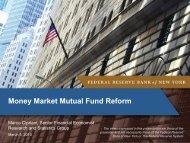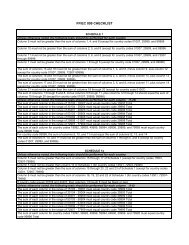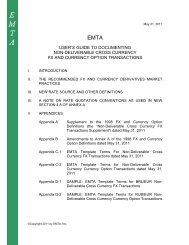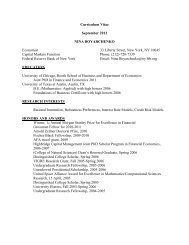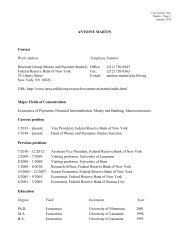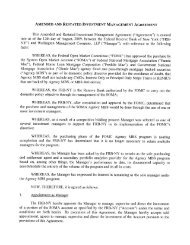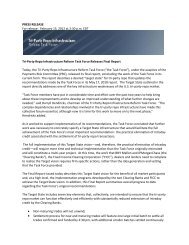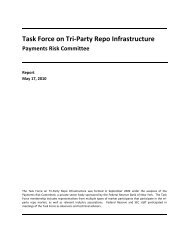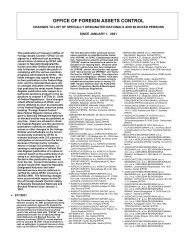Residential Foreclosures in the City of Buffalo, 1990-2000 - Federal ...
Residential Foreclosures in the City of Buffalo, 1990-2000 - Federal ...
Residential Foreclosures in the City of Buffalo, 1990-2000 - Federal ...
You also want an ePaper? Increase the reach of your titles
YUMPU automatically turns print PDFs into web optimized ePapers that Google loves.
more than four years old at default. Thus, foreclosures on <strong>the</strong>se older loans <strong>the</strong>mselves<br />
represent significant growth <strong>in</strong> foreclosures over <strong>the</strong> decade.<br />
Borrowers<br />
Overall, our study suggests that <strong>the</strong>re is no simple explanation for <strong>the</strong> rise <strong>in</strong> foreclosures;<br />
<strong>the</strong> divergent patterns <strong>of</strong> foreclosure among communities raise more questions than <strong>the</strong>y<br />
answer. But while <strong>the</strong> circumstances that brought homeowners to <strong>the</strong> br<strong>in</strong>k <strong>of</strong> foreclosure<br />
may have varied, many faced a similar predicament once <strong>the</strong>y entered <strong>the</strong> foreclosure<br />
process: <strong>the</strong>ir homes tended to be worth significantly less than <strong>the</strong> rema<strong>in</strong><strong>in</strong>g balance on<br />
<strong>the</strong>ir mortgage loans. Thus, a large proportion <strong>of</strong> distressed homeowners were unable to<br />
prevent foreclosure through <strong>the</strong> sale <strong>of</strong> <strong>the</strong>ir property and had little <strong>in</strong>centive to work out<br />
an alternative to foreclosure even if <strong>the</strong>y could.<br />
In some cases, <strong>the</strong> high judgment-to-value ratios faced by borrowers at<br />
foreclosure may be due to high loan-to-value ratios at orig<strong>in</strong>ation. Without question,<br />
though, a lead<strong>in</strong>g contributor to <strong>the</strong>se circumstances is <strong>the</strong> widespread decl<strong>in</strong>e <strong>in</strong> home<br />
prices <strong>in</strong> <strong>the</strong> city. Consequently, homeownership can be a precarious proposition <strong>in</strong> some<br />
<strong>Buffalo</strong> neighborhoods because it is an <strong>in</strong>vestment likely to depreciate over time.<br />
The Homeownership-Foreclosure Equation<br />
In many ways, <strong>the</strong> <strong>in</strong>crease <strong>in</strong> and <strong>the</strong> distribution <strong>of</strong> foreclosures may result from<br />
socioeconomic forces over which city government, hous<strong>in</strong>g advocacy groups, and federal<br />
agencies have little control. The forces beh<strong>in</strong>d urban and regional change are powerful<br />
and pervasive. However, our f<strong>in</strong>d<strong>in</strong>gs suggest <strong>the</strong> need for a comprehensive evaluation <strong>of</strong><br />
urban homeownership policy. In cities such as <strong>Buffalo</strong>, homeownership <strong>of</strong>ten entails a<br />
match between a region’s lowest <strong>in</strong>come borrowers and its most precarious real estate<br />
markets. The recent rise <strong>in</strong> foreclosures may <strong>in</strong> part reflect <strong>the</strong> risks associated with such<br />
a match, and <strong>the</strong> difficulty that both <strong>the</strong> markets and <strong>the</strong> government have <strong>in</strong> provid<strong>in</strong>g<br />
hous<strong>in</strong>g and f<strong>in</strong>ancial products suitable for low-<strong>in</strong>come homeownership <strong>in</strong> urban<br />
neighborhoods.<br />
Homeownership is generally believed to be good for people, good for<br />
neighborhoods, and good for society as a whole. It is no wonder that many wish to see<br />
68



